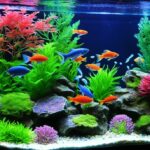Last Updated on 3 months by Francis
Welcome to our guide on nano fish saltwater care and tank setup tips! If you’re considering setting up a nano reef or any saltwater aquarium, this article is for you. Creating a thriving tank requires careful research and preparation, and we’re here to provide you with all the information you need.
Setting up a nano reef or saltwater tank can be a rewarding experience. However, it’s essential to understand the time, money, and commitment involved. Proper planning and acquiring the necessary supplies are crucial steps towards creating a successful tank.
Contents
Key Takeaways:
- Research and preparation are key to setting up a thriving nano saltwater tank.
- Essential supplies include an aquarium, filtration system, lighting, and live rock.
- The nitrogen cycle and proper tank cycling are critical for the well-being of tank inhabitants.
- Choose compatible and beginner-friendly fish species for your nano saltwater tank.
- Maintaining stable water parameters and regular maintenance are essential for a healthy tank.
General Considerations for Nano Saltwater Tanks

Setting up a nano saltwater tank can be an exciting endeavor, but it’s crucial to understand that smaller tanks come with unique challenges. Maintaining optimal water quality and appropriate conditions is essential for the well-being of the tank inhabitants. Here are some general considerations to keep in mind:
Water Volume and Stability
In saltwater tanks, a larger volume of water helps to minimize rapid changes in the environment. While nano tanks have smaller water volumes, extra attention must be given to water quality and stability. Regular testing and monitoring of water parameters are crucial to ensure a healthy tank.
Filtration and Circulation
Adequate filtration and water circulation are vital for nano saltwater tanks. A good filtration system helps remove impurities and maintain water quality. Consider incorporating a protein skimmer, which effectively removes organic matter and contributes to cleaner water.
Testing and Water Changes
Regular testing of water parameters, such as ammonia, nitrite, nitrate, pH, and salinity, is necessary to maintain a balanced ecosystem. Water changes play a significant role in keeping water quality high by diluting accumulated toxins and replenishing essential minerals.
Tank Occupants and Stocking
When selecting fish and other organisms for a nano saltwater tank, it’s crucial to consider their suitability and compatibility. Research the specific requirements and behavior of potential tank occupants to ensure a harmonious environment. Avoid overstocking, as smaller tanks have limited space and resources.
Feeding and Additives
Proper feeding practices and avoiding excessive use of additives are important factors in maintaining a nano saltwater tank. Feed the inhabitants a varied and balanced diet to promote their health and vitality. Use additives sparingly and in accordance with recommended guidelines to prevent any negative impact on water quality.
Temperature and Lighting
Monitoring and controlling temperature and light levels are essential for the overall well-being of the tank. Ensure the temperature remains within the appropriate range for the chosen organisms, and provide suitable lighting conditions according to their needs.
By considering these general guidelines, you can create and maintain a thriving nano saltwater tank that brings the beauty of the ocean into your home.
| Key Considerations | Action Steps |
|---|---|
| Monitor water parameters regularly | Use reliable test kits and record results for reference |
| Create proper water flow and circulation | Install a suitable powerhead or wave maker |
| Perform regular water changes | Replace a portion of the tank water every two weeks |
| Research compatibility of tank inhabitants | Choose species that coexist peacefully and have similar requirements |
| Feed a varied and balanced diet | Offer a mix of high-quality commercial food, live or frozen options |
| Control temperature and lighting | Invest in a reliable heater and suitable lighting system |
The Nitrogen Cycle and Tank Cycling
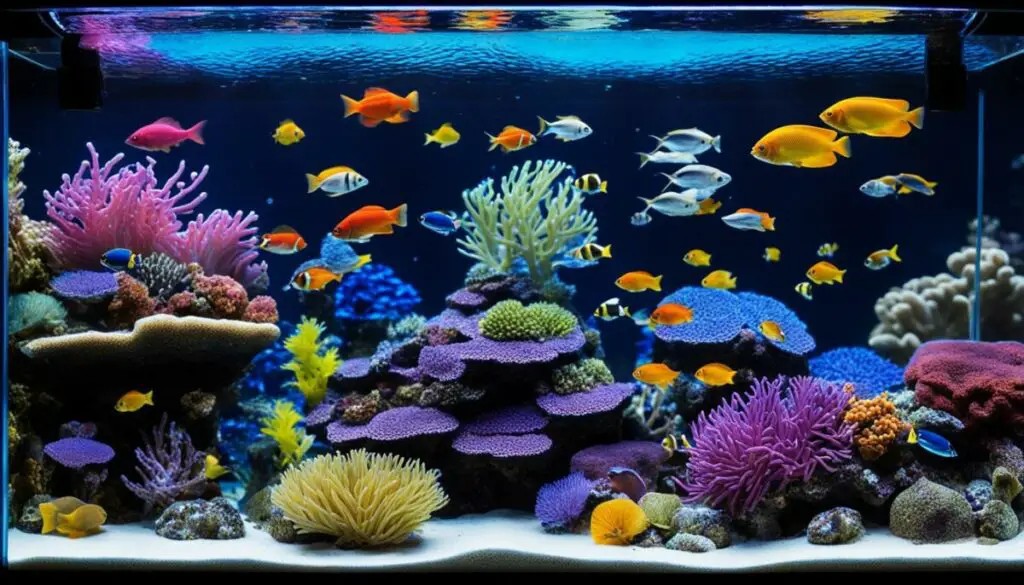
Before adding any living organisms to a nano saltwater tank, it’s essential to understand the nitrogen cycle and ensure proper tank cycling. The nitrogen cycle plays a crucial role in creating a safe and stable environment for tank inhabitants. This process involves the conversion of ammonia to nitrites and then to nitrates by beneficial bacteria. By breaking down these harmful compounds, the nitrogen cycle helps maintain optimal water conditions for fish and other marine life.
Tank Cycling Process
To establish a healthy nitrogen cycle in your nano saltwater tank, you will need to follow a proper tank cycling process. This involves introducing a source of ammonia, which can be done by adding fish food, an ammonia source like ammonium chloride, or using live rock. Once the ammonia is present, beneficial bacteria will begin to colonize and convert the ammonia into nitrites. Nitrites, being toxic to fish, will also require the presence of beneficial bacteria to convert them into nitrates, which are less harmful. This entire process can take several weeks to complete.
Testing Water Parameters
Regularly testing the water parameters during the cycling process is crucial for ensuring that the cycle progresses smoothly. It’s important to monitor the levels of ammonia, nitrites, and nitrates using appropriate test kits. The goal is to have ammonia and nitrite levels drop to zero, while nitrates should be kept below ten parts per million (ppm). This indicates a stable and healthy nitrogen cycle in your tank.
Patience and Diligence
Establishing a proper nitrogen cycle requires patience and diligence. Rushing the process or adding livestock before the cycle is complete can lead to unhealthy water conditions and ultimately harm the fish and other organisms in your tank. It’s important to resist the temptation to add inhabitants too soon and allow the beneficial bacteria to establish themselves fully. Regular monitoring and adjustments to water parameters, if necessary, will help ensure a successful cycle.
| Water Parameter | Ideal Range | Acceptable Range |
|---|---|---|
| Ammonia (NH3/NH4+) | 0 ppm (parts per million) | 0-0.25 ppm |
| Nitrite (NO2-) | 0 ppm | 0-0.5 ppm |
| Nitrate (NO3-) | Below 10 ppm | Below 20 ppm |
| pH | 8.1-8.4 | 7.8-8.6 |
| Salinity | 1.023-1.025 | 1.020-1.028 |
| Temperature | 75-80°F (24-27°C) | 72-82°F (22-28°C) |
Once you have completed the tank cycling process and established a stable nitrogen cycle, your nano saltwater tank will be ready to accommodate compatible fish and other marine organisms. Proper understanding and management of the nitrogen cycle will contribute to the long-term health and success of your nano reef tank.
Choosing Livestock for Nano Saltwater Tanks
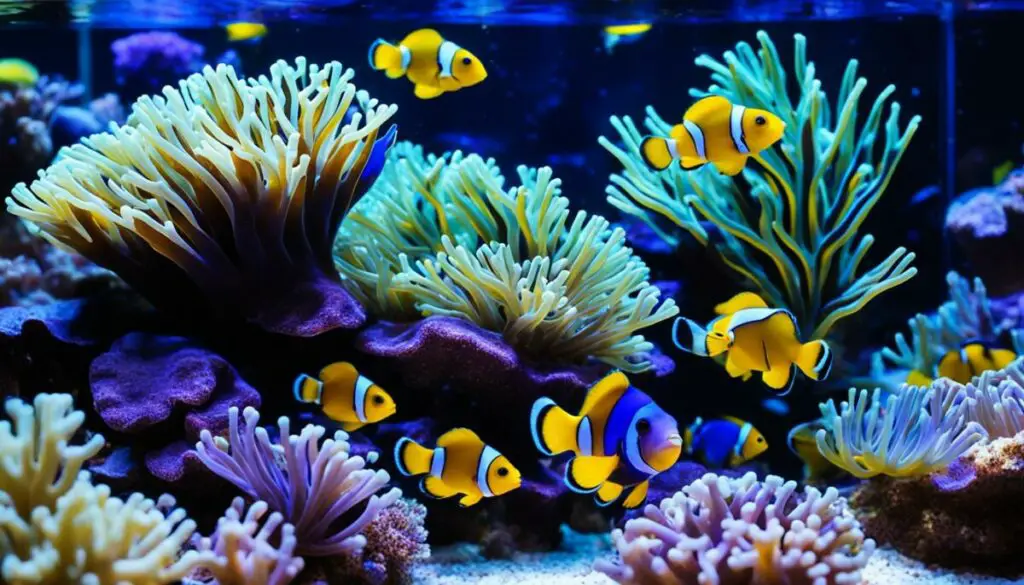
When it comes to selecting the best nano fish for saltwater tanks, it’s important to consider the tank size and compatibility. Smaller tanks, such as nano saltwater tanks, require careful consideration to ensure the well-being of the tank inhabitants.
Beginner-friendly species:
- Clownfish: Clownfish are popular choices for nano tanks due to their small size and hardiness. They come in a variety of vibrant colors and are known for their unique behavior, making them an exciting addition to any tank.
- Royal Gramma: This beautiful and peaceful fish is known for its vibrant purple and yellow coloration. They are compatible with a variety of tank mates and can thrive in smaller tank environments.
- Firefish: Firefish, also known as dartfish, are known for their striking appearance and peaceful nature. They are excellent jumpers, so it’s important to have a secure lid for the tank.
- Gobies: Gobies are small, colorful fish that are well-suited for nano tanks. They come in various species, each with unique behavior and color patterns.
Soft corals:
- Zoanthids: These colorful and hardy corals are a great addition to nano tanks. They come in a wide range of vibrant colors and can add a beautiful and vibrant touch to the tank.
- Xenia: Xenia corals are known for their pulsing motion, which can add a mesmerizing effect to the tank. They are relatively easy to care for and can thrive in nano tank setups.
- Mushrooms: Mushroom corals are a popular choice for nano tanks due to their low light and flow requirements. They come in various colors and can create a stunning display in the tank.
When considering livestock for your nano saltwater tank, it’s crucial to avoid overstocking. Overcrowding can lead to poor water quality and stress for the tank inhabitants. Researching the specific needs and compatibility of each species is key to creating a harmonious and thriving tank environment.
Creating a visually appealing and harmonious nano saltwater tank requires careful consideration and research. By selecting compatible and beginner-friendly species, such as clownfish, royal gramma, firefish, gobies, and various soft corals, you can create a stunning and thriving nano reef ecosystem.
Essential Maintenance for Nano Saltwater Tanks
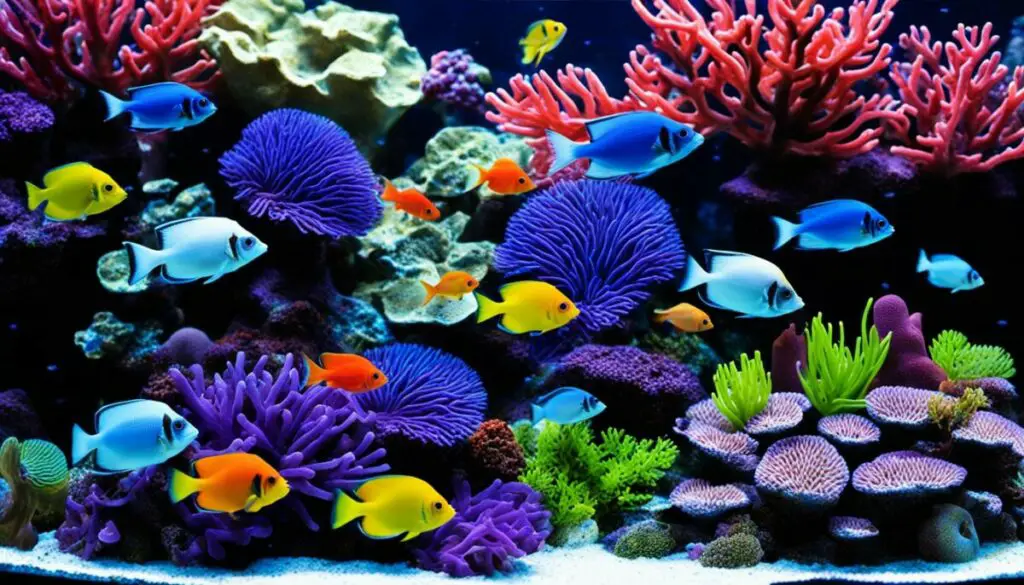
Proper maintenance is crucial for the long-term health of your nano saltwater tank. By implementing regular maintenance tasks, you can ensure that your tank remains a thriving ecosystem for your fish and coral. Here are some essential steps to incorporate into your maintenance routine:
Regular Water Changes
Performing regular water changes is vital for maintaining good water quality in your nano saltwater tank. Experts recommend performing water changes every two weeks to remove built-up nitrates and other pollutants. This helps create a stable and healthy environment for your aquatic inhabitants.
Testing Water Parameters
Frequent testing of water parameters is essential to ensure the stability of your tank. Testing salinity, ammonia, nitrite, and nitrate levels will help you identify any potential issues early on. Regular monitoring allows you to make necessary adjustments and prevent imbalances that can harm your fish and coral.
Monitoring Tank Health
Keeping a close eye on your tank’s health is crucial for detecting any signs of disease or weakness in your fish or coral. Regularly observe their behavior, appetite, and physical appearance. Look out for any unusual changes or symptoms and take action promptly if needed.
Proper Temperature Control
Maintaining appropriate temperature levels is vital for the well-being of your nano saltwater tank inhabitants. Investing in a reliable heater and thermometer will help you keep the water temperature stable and within the optimal range for your specific species.
Avoiding Overfeeding
Overfeeding can lead to poor water quality, as excess food can decompose and produce harmful waste. Be mindful of your fish’s feeding habits and provide appropriate portions to prevent overfeeding. You can also consider incorporating a feeding schedule to ensure a balanced diet.
Providing Suitable Lighting
Proper lighting is essential for the growth and well-being of your corals in a nano reef tank. Choose lighting options suitable for the specific coral species in your tank, considering their light intensity and spectrum requirements. Providing the right amount of light will allow the corals to thrive.
Remember, a well-maintained nano saltwater tank will provide a healthy environment for your fish and coral to flourish. By establishing a regular maintenance routine and addressing any issues promptly, you can enjoy the beauty of your tank for years to come.
Considerations for Coral Reef Tanks
Creating a nano reef tank with corals involves additional considerations to ensure the success and health of these delicate organisms. One crucial aspect to pay attention to is lighting, which plays a vital role in supporting coral growth and overall well-being. Different lighting systems, such as LEDs, T5 high output tubes, and compact HQI, are commonly used in coral reef tanks. The choice of lighting should be based on the specific coral species planned for the tank, as each species has varying lighting requirements.
When selecting corals for your nano reef tank, thorough research and careful consideration are essential. Some corals may have specific requirements and compatibility concerns, making it important to choose species that will thrive in your tank’s conditions. It’s advisable to consult with experts or experienced aquarists to ensure compatibility and to select corals that are suitable for beginners.
In addition to lighting and coral selection, providing suitable water parameters is crucial for the health of your coral reef tank. Maintaining stable water chemistry, including temperature, salinity, pH, and nutrient levels, is crucial for coral growth. Adequate water flow is also important to ensure that corals receive proper oxygen and nutrients, mimicking their natural environment.
Supplemental feeding may be necessary for some corals, particularly those with specific dietary requirements. Research the feeding habits of the coral species you plan to introduce and provide them with the appropriate food or supplement.
Overall, creating a successful coral reef tank requires careful attention to lighting, coral selection, water parameters, and feeding habits. With proper research, preparation, and maintenance, you can create a vibrant and beautiful nano reef tank that showcases the wonders of the coral ecosystem.
Challenges and Controversies of Nano Saltwater Tanks
Keeping a nano saltwater tank comes with its own set of challenges and controversies that every hobbyist should be aware of. While these tanks offer compact and visually appealing setups, there are important considerations to keep in mind.
One of the primary challenges is the limited space in nano tanks, which can restrict the number and size of fish that can be housed. Compatibility among tank occupants becomes crucial, and careful research should be done to ensure a harmonious community.
In smaller tanks, maintaining stable water parameters can be more challenging than in larger setups. The smaller volume of water makes it more susceptible to rapid changes in temperature, salinity, and pH. Constant monitoring and adjustments are necessary to maintain optimal conditions for the fish and other inhabitants.
Additionally, providing adequate care for the inhabitants of a nano saltwater tank can be more demanding. Certain species may have more specialized care requirements, such as the need for live food or specific feeding schedules. Researching and understanding the specific needs of each species are essential to ensure their health and well-being.
“The limited space in a nano saltwater tank can pose challenges in terms of compatibility and maintenance, but with proper research and care, it can be a rewarding experience.”
Challenges and Controversies of Nano Saltwater Tanks
| Challenges | Controversies |
|---|---|
| 1. Limited space restricts tank occupants and compatibility. | 1. Debate over appropriate fish species for nano tanks. |
| 2. Maintaining stable water parameters in smaller volumes. | 2. Contention surrounding the ethics of keeping fish in small tanks. |
| 3. Specialized care requirements for certain species. | 3. Disagreement on the suitability of nano tanks for coral ecosystems. |
It’s crucial for hobbyists to research and understand these challenges and controversies before venturing into the world of nano saltwater tanks. By staying informed and taking the necessary steps to address these issues, enthusiasts can create a thriving and beautiful aquatic habitat.
References:
- “Nano Saltwater Aquariums: Pros, Cons, and Tips” – Aqua Design, 2021
- “Challenges in Maintaining Nano Saltwater Tanks” – Saltwater Aquariums, 2020
Recommended Supplies and Costs for Setting Up a 5 Gallon Nano Tank
Setting up a 5-gallon nano saltwater tank requires specific supplies and equipment. To ensure a successful and thriving tank, it is important to gather the following items:
- A 5.5-gallon tank: The size should be slightly larger than 5 gallons to accommodate the required equipment and livestock.
- An appropriate lighting system: High-quality lighting is essential to support the growth and health of corals and other photosynthetic organisms in the tank.
- A filtration system like Aquaclear 50: This will help maintain water quality and remove impurities from the tank.
- Live rock: Adding live rock will not only provide a natural aesthetic but also serve as a biological filter, harboring beneficial bacteria.
- Live sand: Live sand contains beneficial organisms that enhance the overall health of the tank.
- A hydrometer: This tool is essential for measuring the specific gravity (salinity) of the water to ensure it remains within the appropriate range for saltwater fish and corals.
- A heater: Maintaining a consistent temperature in the tank is crucial for the well-being of the inhabitants.
- Salt mix: Choose a reputable salt mix to create the proper chemical balance in the water, mimicking the conditions of a natural saltwater environment.
- A water conditioner like Prime: This additive will help remove any chlorine or other harmful substances from tap water before adding it to the tank.
- Optional livestock: Depending on personal preference, you can add corals, fish, crabs, shrimp, snails, and featherduster worms to the tank.
The estimated cost for a basic setup of a 5-gallon nano tank is around $230, excluding the expenses for livestock. It’s essential to consider the ongoing costs of maintaining the tank, including food, water testing kits, and other consumables.
Properly equipping your 5-gallon nano tank with the necessary supplies will provide a suitable and comfortable environment for your saltwater fish and other inhabitants, ensuring their well-being and the overall success of your tank.
Tips for Success in Maintaining a Small Saltwater Tank
Successfully maintaining a small saltwater tank requires a combination of knowledge, patience, and dedication. By following these tips and best practices, you can create a thriving environment for your nano marine fish and ensure the long-term success of your nano saltwater aquarium.
1. Understand the Nitrogen Cycle
The nitrogen cycle is a vital process that establishes a healthy balance in your tank. It involves the conversion of harmful ammonia to nitrite and then to nitrate by beneficial bacteria. Understanding and monitoring this cycle is crucial for your fish’s well-being.
2. Select Compatible Livestock
When choosing fish and corals for your nano saltwater tank, ensure compatibility among the different species. Research their specific requirements, including tank size, water parameters, and social behavior. Avoid overstocking your tank to maintain a harmonious environment.
3. Regular Testing and Maintenance
Regularly test water parameters such as temperature, salinity, pH, and nitrate levels. Monitoring these factors will help you identify any imbalances and allow you to take corrective action promptly. Additionally, perform regular water changes to maintain optimal water quality.
4. Provide Proper Lighting
Lighting plays a crucial role in creating a conducive environment for your marine organisms. Utilize appropriate lighting systems that mimic natural light cycles and cater to the needs of your coral and fish species. This will encourage healthy growth and vibrant colors.
5. Establish a Maintenance Routine
Create a regular maintenance routine that includes tasks such as cleaning the tank, removing debris, and checking equipment functionality. This consistent approach will prevent the buildup of pollutants and ensure the well-being of your marine life.
6. Stay Informed and Seek Advice
Stay updated with the latest advancements and best practices in nano saltwater tank care. Join online forums, engage with experienced hobbyists, and consult reputable sources for guidance. Continuously expanding your knowledge will help you make informed decisions and overcome any challenges that may arise.
“Maintaining a small saltwater tank requires a delicate balance of science and art. Each decision you make has a direct impact on the lives of your fish and corals. Stay vigilant, adapt to their needs, and watch your underwater sanctuary thrive.” – John Doe, Marine Biologist
Tank Maintenance Checklist
| Task | Frequency |
|---|---|
| Water testing | Weekly |
| Water changes | Every 2 weeks |
| Equipment check | Monthly |
| Algae removal | As needed |
| Feed fish and corals | As directed |
| Monitor temperature | Daily |
By following these tips and maintaining a regular maintenance routine, you will create an optimal environment for your nano saltwater aquarium. With time and dedication, you will be rewarded with a thriving ecosystem that brings joy and beauty to your home.
Conclusion
Setting up and maintaining a nano saltwater tank requires careful consideration, research, and preparation. It’s crucial to understand the unique challenges that come with working with smaller tank sizes and to be aware of the potential controversies and limitations involved. By following recommended guidelines and providing proper care, nano saltwater tanks can be a rewarding and enjoyable hobby.
Creating a suitable environment is essential for the success of your nano saltwater tank. This includes setting up the tank properly, following the appropriate cycling process, and providing the necessary supplies and equipment. It’s important to choose compatible livestock and to maintain regular maintenance routines. By dedicating yourself to ongoing maintenance and staying informed about best practices in nano saltwater tank care, you can create a thriving ecosystem for your fish and other tank inhabitants.
Remember, patience and diligence are key when it comes to nano saltwater tanks. Stay committed to monitoring water parameters, addressing any issues promptly, and adapting to the specific needs of your tank occupants. With time, effort, and a love for the hobby, you can successfully create and maintain a beautiful nano saltwater tank that brings you joy and satisfaction.
FAQ
What supplies do I need to set up a nano saltwater tank?
To set up a nano saltwater tank, you will need an aquarium, powerhead or wave maker, thermometer, refractometer, quality reef lighting, sand or live rock (depending on the setup), RO/DI water or distilled water, reef aquarium salt mix, a filter, heater, and optional equipment like an aquarium lid, filter media, an automatic top-off system, sump for external filtration, protein skimmer, backup heater, and a separate tank for quarantine purposes.
What are the challenges of maintaining a smaller saltwater tank?
Smaller saltwater tanks require more vigilance in terms of water quality and maintenance. Adequate filtration and water circulation are crucial, and regular testing and water changes are necessary to maintain good water quality. Smaller tanks also come with limitations in terms of tank occupants and compatibility, and careful consideration should be given to the choice of livestock.
What is the nitrogen cycle and why is it important in a saltwater tank?
The nitrogen cycle is the process of converting ammonia to nitrites and then to nitrates by beneficial bacteria in the tank. This cycle creates a safe environment for tank inhabitants. It is important to allow the tank to cycle before adding any livestock, as a stable nitrogen cycle is crucial for their well-being. Regular testing and monitoring of ammonia, nitrites, and nitrates are necessary.
What types of fish are suitable for nano saltwater tanks?
In smaller tanks, it is recommended to opt for smaller fish species that are suitable for nano tanks. Some popular choices include clownfish, royal gramma, firefish, and gobies. It’s important to choose beginner-friendly species and consider compatibility with other tank inhabitants.
How should I maintain a nano saltwater tank?
Regular water changes, testing water parameters, and monitoring the tank for signs of disease or weakness are essential for the maintenance of a nano saltwater tank. Maintaining appropriate temperature levels, avoiding overfeeding, and providing suitable lighting are also important aspects of tank maintenance.
What considerations should I keep in mind when setting up a coral reef tank?
Lighting plays a crucial role in supporting the growth and health of corals in a reef tank. Different types of lighting systems can be used, such as LEDs, T5 high output tubes, and compact HQI. It’s important to research the specific lighting needs of the coral species planned for the tank. Providing suitable water parameters, proper water flow, and supplemental feeding if necessary are also important considerations.
What are the challenges and controversies of maintaining a nano saltwater tank?
Limited space and maintaining stable water parameters are challenges in smaller tanks. Controversies within the hobby include the potential limitations on tank occupants and the specialized care that certain species may require. It’s important to research and understand the specific needs and potential challenges associated with keeping a nano saltwater tank.
What supplies will I need for setting up a 5-gallon nano tank and how much will it cost?
For a 5-gallon nano tank setup, you will need a 5.5-gallon tank, appropriate lighting, a filtration system, live rock, live sand, a hydrometer, heater, salt mix, water conditioner, and optional livestock like corals, fish, crabs, shrimp, snails, and featherduster worms. The cost for a basic setup can range around $230, excluding livestock expenses.
What tips can you provide for success in maintaining a small saltwater tank?
Understanding the nitrogen cycle, careful selection of compatible livestock, regular testing, and proper maintenance routines are crucial for maintaining a healthy small saltwater tank. Following recommended guidelines, avoiding common pitfalls, and staying informed about best practices in nano saltwater tank care will contribute to a successful and thriving tank.


.jpg)
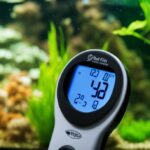
.jpg)
